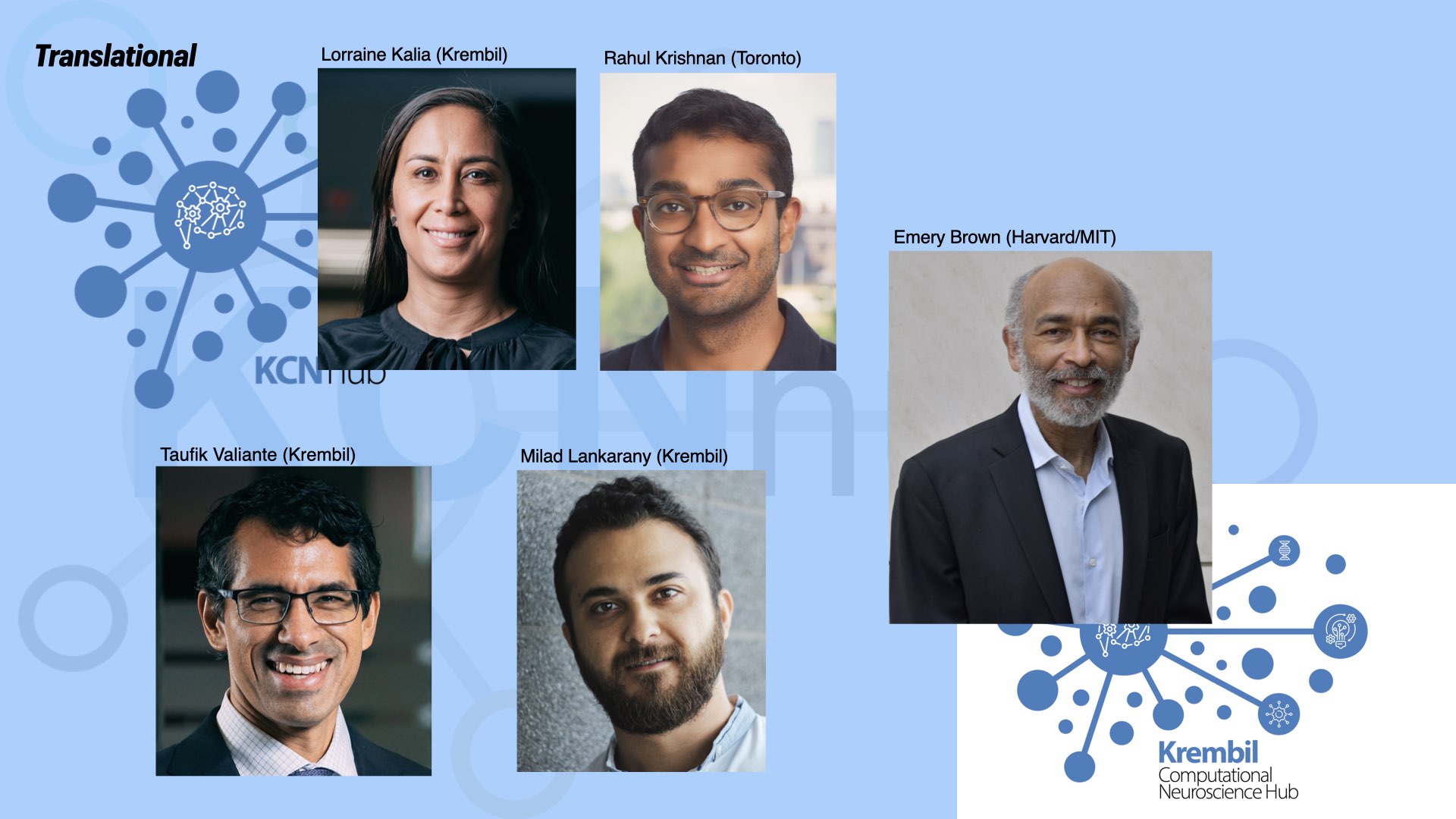KCN Symposium Speakers - DAY 2
Symposium Agenda can be found HERE
LORRAINE KALIA
How can computational methods be applied to drug discovery for Parkinson's disease?
Brief Bio: Dr. Lorraine Kalia is an Associate Professor at the University of Toronto and a Clinician-Scientist at the Krembil Research Institute at Toronto Western Hospital. Her research program aims to understand the key molecular mechanisms responsible for neurodegeneration in Parkinson’s disease and to identify therapeutic agents that can modulate these molecular targets. She holds the Wolfond-Krembil Chair in Parkinson's Disease Research. She is Co-Editor-in-Chief of the Journal of Parkinson’s Disease, Vice-Chair of the International Parkinson and Movement Disorder Society's Scientific Issues Committee and Basic Science Interest Group, and Treasurer of the Canadian Movement Disorders Society.
Abstract:
"Hear from Dr. Lorraine Kalia about her research in Parkinson's disease connecting cellular neuroscience, translational practices and computational approaches."
RAHUL KRISHNAN
Machine learning in healthcare - models, algorithms and applications
Brief Bio: Rahul G. Krishnan is an Assistant Professor of Computer Science and Medicine (Laboratory Medicine and Pathobiology) where he holds a Tier II Canada Research Chair in Computational Medicine. He is a CIFAR AI Chair at the Vector Institute and a member of the Temerty Center for Artificial Intelligence in Medicine. He works on leveraging tools from developing algorithms for probabilistic inference, and applied machine learning to problems in healthcare such as modeling disease progression and risk stratification. Previously, he was a Senior Researcher at Microsoft Research New England. He received his MS from New York University and his PhD in Electrical Engineering and Computer Science from MIT in 2020.
Abstract:
TAUFIK VALIANTE
Loss of neuronal heterogeneity in epileptogenic human tissue impairs network resilience to sudden changes in synchrony
Brief Bio: Dr. Taufik A Valiante, MD PhD FRCS, is an Associate Professor of Surgery at the Faculty of Medicine, University of Toronto, with a sub-specialization in Epilepsy Surgery. In addition to Epilepsy Surgery, he is also an expert in Minimally Invasive Spine Surgery, and Cranial Neurosurgery. Dr. Valiante holds a Senior Scientist appointment, and is the Director of the Surgical Epilepsy Program at the Krembil Brain Institute at the Toronto Western Hospital, University Health Network. In addition to his role at Krembil Brain Institute, he is cross-appointed Associate Professor in the Department of Electrical and Computer Engineering and the Institute of Biomedical Engineering at the University of Toronto. He is also holds the Gerry and Tootsie Halbert Chair in Neural Repair and Regeneration. Dr. Valiante’s vision is to build next generation devices to interrogate and modulate brain activity to cure a whole host of neuropsychiatric conditions. The goal is to one day have implantable devices with the most advanced technology that will address complex brain conditions. Dr. Valiante has also built ‘next generation’ laboratory spaces that are creating novel ecosystems bringing together in real-time basic science, clinical, and diverse scientific fields. Dr. Valiante's research leverages access to the human brain through surgical treatment to enable Canadian first research that spans from single neuron biophysics to the collective behavior of the billions of neurons underlying human cognition. The research uses various techniques to interrogate cortical circuits including electrophysiology, behavior, optogenetics, and transcriptomics. His efforts have been recognized by leaders nationally and internationally through supports to establish world-class infrastructures here in Toronto. He has notably established the Max Planck-University of Toronto Centre (MPUTC) for Neural Science and Technology; the Centre for Advancing Neurotechnological Innovation to Application (CRANIA); and the CRANIA Neuromodulation Institute (CNMI). These entities are driving the intersectionality of non-traditional scientific fields of medicine, engineering, and computational neuroscience working together to advance our knowledge and discovery potential that spans from the neuron to the whole brain. These centres of excellence are helping to train the next generation of scientists and leaders in Neuromodulation specialization (CNMI), building first of its kind neuromodulatory devices and interventions that will address complex brain diseases (CRANIA), and enable the pursuit of developing new physical tools and computation to explore the brain (MPUTC). Dr. Valiante credits his success to the strong engagement of the Epilepsy Community through which this work would not be possible. Dr. Valiante strongly believes in the need for institutions to bring patient partners and communities to the table to help inform and drive research that meets their needs and is informed by what matters most to them. He has been involved in numerous community Boards and agencies, where he became acutely aware of the needs of the community, in particular, the lack of awareness and access to surgical services. Working closely with community partners, UHN and SickKids administration, he developed the chronic disease model that was the basis of the Provincial Epilepsy Strateigy, which is a hub-and-spoke model of Epilepsy care in Ontario, predicated on the emerging principles of Chronic Disease Management and WHO’s Innovative Care for Chronic Disease. This has led to Ontario being the only place in the world with a regionalized approach to Epilepsy Care.
Abstract:
"His research is largely focused on the development of neurotechnology, with work in the biophysical properties of neurons, epilepsy, neuromodulation, and computational modelling"
MILAD LANKARANY
Inferring and modulating latent state of conflict processing in verbal stroop task
Brief Bio: Dr. Lankarany is a Scientist at the Krembil Research Institute and an Assistant Professor at the University of Toronto. He is an emerging leader in the fields of computational neuroscience, artificial intelligence, and deep brain stimulation. His research is directed toward (1) understanding the biophysical and computational mechanisms of neural information processing at the cellular and network levels, and (2) developing neurotechnology to better understand, monitor, and treat diseases associated with aberrant information processing. The research led by Dr. Lankarany has the potential to accelerate developments in the treatment of common neurological conditions, such as Parkinson’s disease and epilepsy.
Abstract:
"He has developed a modern technique to link neural activity and behavioural signals during conflict processing in Parkinson's Disease!"
EMERY BROWN
General anesthesia, neuromodulation and altered states of arousal
Brief Bio: Emery N. Brown, M.D., Ph.D. is the Edward Hood Taplin Professor of Medical Engineering and Computational Neuroscience at MIT; the Warren M. Zapol Professor of Anaesthesia at Harvard Medical School; and an anesthesiologist at Massachusetts General Hospital (MGH). He received his B.A. in Applied Mathematics (magna cum laude) from Harvard College, his M.A. and Ph.D. in statistics from Harvard University and his M.D. (magna cum laude) from Harvard Medical School. Professor Brown completed his internship in internal medicine at the Brigham and Women’s Hospital and his anesthesiology residency at MGH. Professor Brown is an anesthesiologist-statistician whose research is defining the neuroscience of how anesthetics produce the states of general anesthesia. He also develops statistical methods for neuroscience data analysis. Professor Brown is a fellow of the IEEE, the American Association for the Advancement of Science, the American Academy of Arts Sciences, and the National Academy of Inventors. He is a member of the U.S. National Academy of Medicine, U.S. National Academy of Sciences, and the U.S. National Academy of Engineering. Professor Brown has received an NIH Director’s Pioneer Award, an NIH Director’s Transformative Research Award, the Sacks Prize from the National Institute of Statistical Science, a Guggenheim Fellowship in Applied Mathematics, the American Society of Anesthesiologists Excellence in Research Award, the Dickson Prize in Science, the Swartz Prize for Theoretical and Computational Neuroscience, the Pierre Galletti Award, the Gruber Prize in Neuroscience, and a Doctor of Science Honoris Causa from the University of Southern California.
Abstract: General anesthesia is a drug-induced, reversible condition comprised of five behavioral states: unconsciousness, amnesia (loss of memory), antinociception (loss of pain sensation), akinesia (immobility), and hemodynamic stability with control of the stress response. Our work shows that a primary mechanism through which anesthetics create these altered states of arousal is by initiating and maintaining highly structured oscillations. These oscillations impair communication among brain regions. We illustrate this effect by presenting findings from our human and non-human primate studies using high-density EEG recordings and intracranial recordings. These studies have allowed us to give a detailed characterization of the neurophysiology of loss and recovery of consciousness due to propofol, and more recently ketamine. We show how these dynamics change systematically with different anesthetic classes and with age. As a consequence, we have developed a principled, neuroscience-based paradigm for using the EEG to monitor the brain states of patients receiving general anesthesia. We demonstrate that the state of general anesthesia can be rapidly reversed by activating specific brain circuits. Finally, we demonstrate that the state of general anesthesia can be controlled using closed-loop feedback control systems. The success of our research has depended critically on tight coupling of experiments, signal processing research and mathematical modeling.

